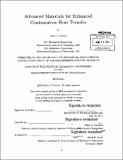| dc.contributor.advisor | Kripa K. Varanasi. | en_US |
| dc.contributor.author | Paxson, Adam Taylor | en_US |
| dc.contributor.other | Massachusetts Institute of Technology. Department of Mechanical Engineering. | en_US |
| dc.date.accessioned | 2014-12-08T18:53:57Z | |
| dc.date.available | 2014-12-08T18:53:57Z | |
| dc.date.copyright | 2014 | en_US |
| dc.date.issued | 2014 | en_US |
| dc.identifier.uri | http://hdl.handle.net/1721.1/92168 | |
| dc.description | Thesis: Ph. D., Massachusetts Institute of Technology, Department of Mechanical Engineering, 2014. | en_US |
| dc.description | Cataloged from PDF version of thesis. | en_US |
| dc.description | Includes bibliographical references (pages 147-164). | en_US |
| dc.description.abstract | This thesis investigates the use of three classes advanced materials for promoting dropwise condensation: 1. robust hydrophobic functionalizations 2. superhydrophobic textures 3. lubricant-imbibed textures We first define the functional requirements of a hydrophobic functionalization for promoting dropwise condensation and use these guidelines to investigate two subclasses of materials: rare-earth ceramics and fluoropolymer films deposited via initiated chemical vapor deposition (iCVD). We show how both materials exhibit robust dropwise behavior, and further subject an iCVD film to an accelerated endurance trial to show how it sustains dropwise condensation throughout a 3-month equivalent trial. Next we combine hydrophobic functionalization with rough texture to obtain superhydrophobic surfaces and identify a self-similar depinning mechanism governing adhesion on surfaces with multiple roughness length scales. We introduce the metric of pinned fraction to show how these surfaces must be designed to minimize adhesion. We then show how dropwise condensation on superhydrophobic surfaces and the ensuing "jumping" behavior consists of not only binary coalescences, but multiple-drop coalescences with tangential departure that result in increased departing mass flux. However, we find that although this mode of condensation is readily achievable when condensing working fluids with high surface tension, such as water, even re-entrant structures that are known to support millimetric droplets of low-surface tension liquids in a superhydrophobic state are not sufficient to promote the dropwise mode of condensation for working fluids with low surface tension. Finally, we extend the applicability of textured surfaces by imbibing solid textures with a lubricant stabilized by capillary wicking. We show how these surfaces, when both solid texture and lubricant are properly designed, can promote dropwise condensation and reduce departing diameter of not only steam, but also of low-surface tension working fluids. In summary, we find that all three classes of surfaces provide significant increases in vapor-side heat transfer coefficient. However, when considering the overall heat transfer coefficient of a surface condenser, we find that most of the benefits of dropwise condensation can be realized by hydrophobic functionalization. | en_US |
| dc.description.statementofresponsibility | by Adam T. Paxson. | en_US |
| dc.format.extent | 164 pages | en_US |
| dc.language.iso | eng | en_US |
| dc.publisher | Massachusetts Institute of Technology | en_US |
| dc.rights | M.I.T. theses are protected by copyright. They may be viewed from this source for any purpose, but reproduction or distribution in any format is prohibited without written permission. See provided URL for inquiries about permission. | en_US |
| dc.rights.uri | http://dspace.mit.edu/handle/1721.1/7582 | en_US |
| dc.subject | Mechanical Engineering. | en_US |
| dc.title | Advanced materials for enhanced condensation heat transfer | en_US |
| dc.type | Thesis | en_US |
| dc.description.degree | Ph. D. | en_US |
| dc.contributor.department | Massachusetts Institute of Technology. Department of Mechanical Engineering | |
| dc.identifier.oclc | 897133897 | en_US |
